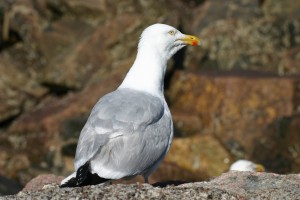 This was Nairn harbour on an average wintry December day with a stormy sea and a high tide producing some spectacular seascapes. As is often the case, there was no snow actually along the shoreline but I had driven through lying snow on the roads from Inverness and all the hills to the north were snow capped. However, there was something wrong which I could not identify as everything looked normal. There were the usual waders around and they kept flying around in small groups as if they were waiting for the tide to ebb to get back to the very rich feeding grounds. For example, a party of 50 plus redshank kept flying past, first over the sea and then over the harbour to the fields beyond where they would rest awhile before setting off as if just checking they still had the tide right.
This was Nairn harbour on an average wintry December day with a stormy sea and a high tide producing some spectacular seascapes. As is often the case, there was no snow actually along the shoreline but I had driven through lying snow on the roads from Inverness and all the hills to the north were snow capped. However, there was something wrong which I could not identify as everything looked normal. There were the usual waders around and they kept flying around in small groups as if they were waiting for the tide to ebb to get back to the very rich feeding grounds. For example, a party of 50 plus redshank kept flying past, first over the sea and then over the harbour to the fields beyond where they would rest awhile before setting off as if just checking they still had the tide right.
Another party of waders, this time knot, flew past but they were heading south as if for a set purpose, so perhaps they knew of some inland feeding grounds. They looked so white and contrasted sharply with the darkening sky as a storm was brewing and coming down from the north. One of my favourite waders is the turnstone and they too had had to leave the shoreline with such a high tide and some of them were in the harbour on top of the breakwater and occasionally picking up some scraps of food. No doubt they we anxious to get back to their more usual diet of food such as mussels, sand hoppers and tiny crabs once the tide had ebbed. Unlike many of the other over-wintering waders, these small birds, only about the size of a blackbird, do not breed in Scotland but winter sees around 35,000 of them over-wintering in Scotland!
Other birds included the carrion and hooded crows that seemed oblivious to the people and cars and were just scavenging as only the crows can. Amongst the cars was a single pied wagtail, ever on the move as usual, but it seemed wary of the crows as it just avoided them. Other birds included three that looked like rock doves and I wondered where they originally came from as the only pure rock doves now seem to be up on the north west coast around Ullapool. The feral birds, as the three at Nairn almost certainly were, are now widespread and these are the ones you see in urban situations yet also along the coasts as they seem to just adapt.
Then, for some unknown reason, I suddenly realised what was wrong as there were very few gulls around. There were one or two quartering the tideline that had a just turned and a few out to sea but that was all. It looked very much as though the moves by the Local Authority to stop people feeding gulls had paid off. There were several signs along the front simply saying “please do not feed the seagulls” with two drawings of gulls and then smaller lettering above saying “In the interest of hygiene and safety let nature take care of itself”. This widespread policy of the Authority has paid off as you no longer see the accumulations of gulls in such places as along the front of the River Ness in Inverness. This used to be a favourite place for people to feed gulls and ducks but no more. On the nesting front the Authority has been busy again with some 4,000 eggs and 2,500 nests removed in and around Inverness. Could it be that the gulls nesting on rooftops in Inverness has been a thing of the past?
Tags: highland wildlife
